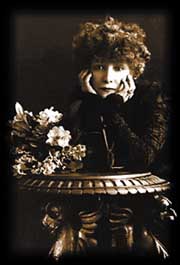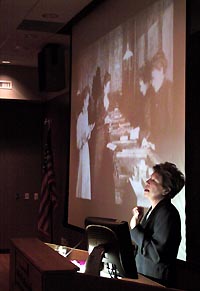|
This is an archived article.
For the latest news, go to the Advance
Homepage
For more archives, go to the Advance Archive/Search Page. |
||||
|
Bernhardt Played Disruptive Role
Challenging Gender Norms By Elizabeth Omara-Otunnu
Roberts spoke about the famous actress during a lecture in the Visiting Scholars in Gender and History series, in Konover Auditorium Nov. 4. She illustrated her talk with contemporary quotations, photographs, and cartoons.
A historian of modern France and European women's history, Roberts said she was introduced to Bernhardt during her research on La Fronde, the first daily newspaper in France published by and for women in the late 19th century. She became curious as to why the paper's staff, which included many of France's first professional women, idolized Bernhardt despite their feminist leanings. At the time, said Roberts, it was commonly held that a woman's destiny was to be a wife and mother, to be nurturing and self-sacrifici ng. These qualities were regarded as essential and fixed. Yet, "through a series of disruptive acts, women exposed gender norms," said Roberts. "Actresses in general, and Sarah Bernhardt in particular, participated in this disruptive process." Roberts said the late 19th century "was a period of history when the cultural life of the theater was at its peak. There was no television. The stage was the center of entertainment and the center of public discussion," she said. "The disruptive potential of actresses could not be ignored." Bernhardt "crossed the stage more often as a man than as a woman," said Roberts. When asked why she liked men's roles, the actress replied that most women's parts were mere play, a matter of looking pretty and portraying emotions. Roberts said the "most conventionally female moment" of Bernhardt's life was her marriage in 1882 to the son of a Greek shipping tycoon. Yet the marriage, "arguably the centerpiece of a woman's life at this period," led to uproar, she said. The public was outraged that Bernhardt was the one who proposed. Commentators suggested that the marriage was "nothing more than fantasy" or play acting, and one predicted that although Act 1 took place in church, Act 2 would be played out in the divorce court. Although Bernhardt's marriage did represent "a nod to convention — it was the triumph of the 'new woman' rather than the conventional woman," Roberts said. "Convention sat uneasily on unconventional shoulders." Bernhardt demonstrated her unconventionality in a variety of ways. She had a menagerie of pets, for example, including - over time - greyhounds, a poodle, a bull mastiff, a parrot, a monkey, six chameleons, two alligators, a lynx, a lion and a puma. She also, when in her teens, bought a coffin, practiced sleeping in it, and was once even photographed in it. "Sarah Bernhardt's eccentricity was a rebellion against the restrictive roles for women," said Roberts. Her eccentricity was also a matter of looks, she said. She was so thin that, unlike most women of the period, she never wore a corset. She was portrayed in cartoons as a needle or a corkscrew, and was often compared to a snake. The suppleness of her body was viewed as "a symbol of the malleability of her soul," Roberts said. As an actress, she played an extremely wide range of roles. This ability to assume a virtually unlimited set of identities had a special disruptive meaning for the prevailing notions of womanhood, Roberts argued, but it was also appealing to women who were trying to shape new identities apart from the domestic ideal. "The proper middle-class woman was exposed as a role, not a destiny," she said. Bernhardt disturbed the norms of race as well as of gender, Roberts added. Although she considered herself Catholic, her mother was Jewish. When in 1889 she played Joan of Arc, there was outrage that a Jewish woman should play the role of a woman who was "indisputably Christian". Sarah Bernhardt was "capable of inspiring all the love and adoration, revulsion and hatred of an era," Roberts concluded. "Fantasy became a way to escape the strictures of gender and race." |
 ne hundred years ago, an
actress with unruly red hair and a sinuous pose brought Paris to
its feet and captured the attention of audiences worldwide.
According to Mary Louise Roberts, a professor of history at the
University of Wisconsin-Madison, the appeal of Sarah Bernhardt -
once dubbed the eighth wonder of the world - lay in her ability to
challenge the gender norms of her day.
ne hundred years ago, an
actress with unruly red hair and a sinuous pose brought Paris to
its feet and captured the attention of audiences worldwide.
According to Mary Louise Roberts, a professor of history at the
University of Wisconsin-Madison, the appeal of Sarah Bernhardt -
once dubbed the eighth wonder of the world - lay in her ability to
challenge the gender norms of her day.

